The latest Q3 2014 adidas group results are in, and things are looking good for the German brand. While they were some setbacks due to Russia, unfavorable foreign currency fluctuations and decline in the Golf business, performance football (soccer) and running were bearers of good tidings, among other positives.
It doesn’t take a degree in business management to see where that upside in the running category is coming from, besides annual retail price hikes. Today, most of adidas running franchises come boxed riding on the Boost foam, and that has proven to be a game changer of sorts for Herzogenaurach.
Of course, not all was perfect. While product mediocrities like Pure Boost and Response Boost tech fit didn’t quite make the cut, cornerstones like the Energy Boost, Glide Boost and adios/Boston Boost cheered up the overall picture. Our impression of most Boost shoes has been positive, and adidas should have little problem building on the first wave of line refreshes.
(Related: Read our Energy Boost 2 review for a complete lowdown of Boost foam)
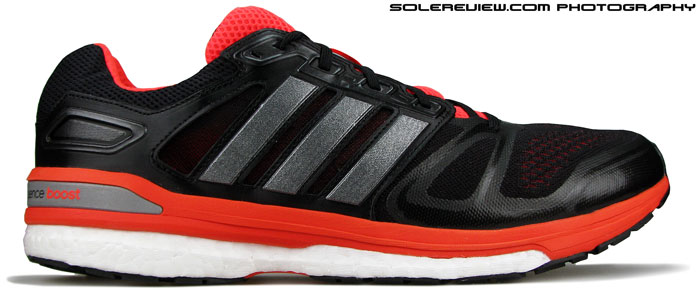
The Fall 2014 Sequence 7 Boost is a refresh of the Sequence franchise, but with Boost being part of the shoe. This naturally brings a change to everything that was once familiar.
On solereview, we’ve got most of Boost models in performance running covered, save for a few. We haven’t been able to look at the Adistar Boost yet, and till today, Supernova Sequence 7 Boost. It’s too late in the day for adistar, which we’ll probably pick up when its second version releases in 2015. But we can end 2014 (for adidas Boost) with a review of the Sequence 7, a Fall 2014 release. This is a shoe which pairs up with the Supernova Glide 6 as its more firmer and stabler version, as it has been the case historically – even when the shoes existed in their pre-Boost avatars.
We haven’t tested the previous generation Sequence 6, but if our experience with comparing the Formotion based Glide 4 and Glide Boost is anything to go, the new Sequence will share little with its predecessor. Inclusion of the Boost foam puts a new tint on everything, right from the absence of Formotion unit to the way in which stability is delivered.
And we say this because the Supernova Sequence behaves rather differently from other stability competitors in the running shoe market. Intrigued? But first, as with most of our reviews, we’ll do a quick rundown of design and construction to warm things up, and then work our way downwards from there.
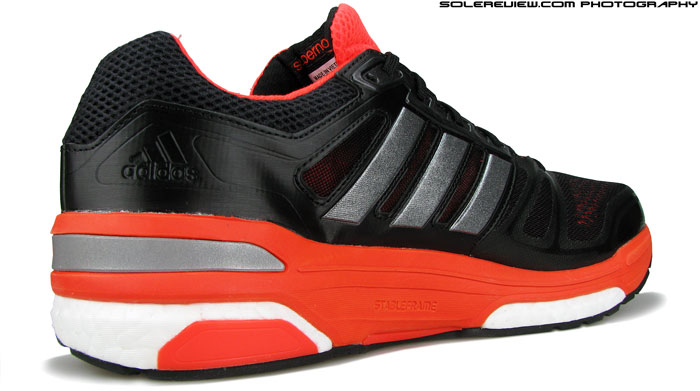
The Sequence 7 does away with Pro-moderator shank and instead uses an extension of ‘StableFrame’ layer to provide medial support.
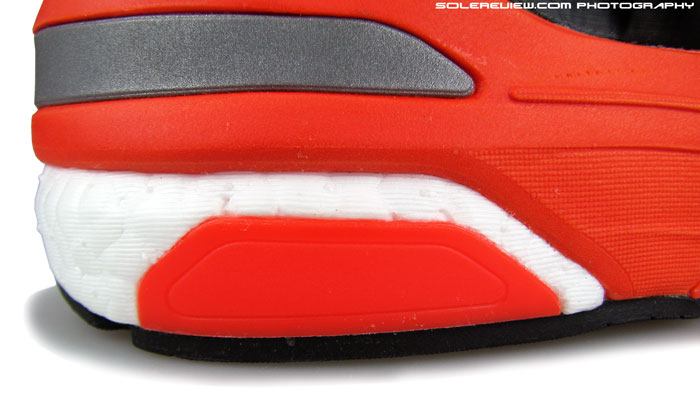
The Torsion shank rises up from outsole in shape of a ‘levee’. This supports the heel Boost foam. The big, grey strip located in upper midsole is reflective. Red EVA foam acts as a firmer layer of cushioning over the Boost midsole.
The midsole has three basic components stacked together; a layer of white Boost foam, a compression molded EVA bed which adidas calls the Footframe, and finally a plastic ‘Torsion’ shank. Given Sequence 7’s positioning, the midsole construction gets an increased dose of stability features. The Torsion shank extends beyond its designated midfoot area and into medial heel area. You can see the red colored underlay under heel outsole, and this piece extends upwards on the midsole wall to form a kind of dam. Yes, if this sounds familiar, then your hunch is right – we saw the same execution in the much plumper Energy Boost 2.
The firm EVA frame extends upwards around the upper heel base, and creates a cup like shape for the foot to sit in, and not on top of the shoe. A gigantic wrap of low light visibility (reflective) element goes around the heel, and adidas chooses this part to display the shoe name. While the upper does not come with any other form of reflectivity, the heel component more than makes up for it with its three-side coverage.
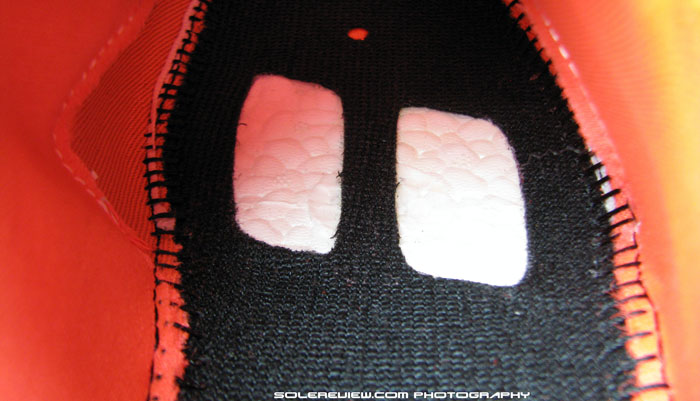
Like the Glide Boost, forefoot cut-outs increases responsiveness. See the red dot ahead of that? That’s firm EVA underneath the toe area.
Boost foam volume isn’t as much as what’s on more cushioned shoes like the Energy Boost, its levels adjusted to what adidas felt would be apt for a stability shoe. When it comes to the amount of Boost used in Sequence 7, what you see is what you get. There’re no hidden chambers or areas where there’s more Boost than what meets the eye.
The proprietary cushioning platform spans across 80% of total midsole length, ending in the forefoot. EVA (from the upper layer) completes rest of the journey till toe tip. A helpful visual cue is inside the shoe; take off the removable insole and you’ll see the cut-out area of Boost in forefoot and red EVA visible in the heel. And if you take an even closer look, it reveals that the area just ahead of forefoot cut-outs has red EVA, indicating that Boost foam does not extend further than the cut-outs.
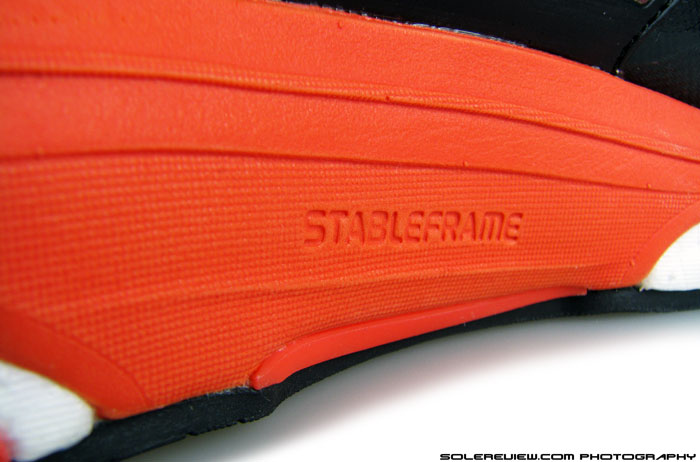
Under Arch area is filled with EVA from StableFrame midsole, and functionally replaces the Pro-Moderator.
In what is a variation of traditional medial post design, StableFrame EVA drops downwards on the medial (inner) midfoot side, forming the entire midsole wall. If you were looking for the ‘Promoderator’ insert, there isn’t any. This new set-up replaces the earlier concept.
At this juncture, we’d like to highlight that the EVA is firm but nowhere as hard as midsole rims used on shoes such as Adios and Glide Boost. It has a certain amount of cushioning, relatively speaking, but toward the denser side. In terms of Boost foam stack heights, the Sequence 7 visually compares to Boston Boost , except that Sequence has a wider base, hence resulting in a higher overall volume.
Combination of these factors greatly influence how the Sequence Boost rides; which it does so in a way different from other pronation control shoes.
The Sequence Boost cuts no corner on outsole rubber, with a single Continental branded sheet spanning heel to toe. There’s an exposed groove (heel to forefoot) separating the outsole into two halves with a perforated lateral side, it’s likely goal being to deliver a softer transition.
Does that design feature make itself felt during runs? We couldn’t tell, really, but no harm done with that design.
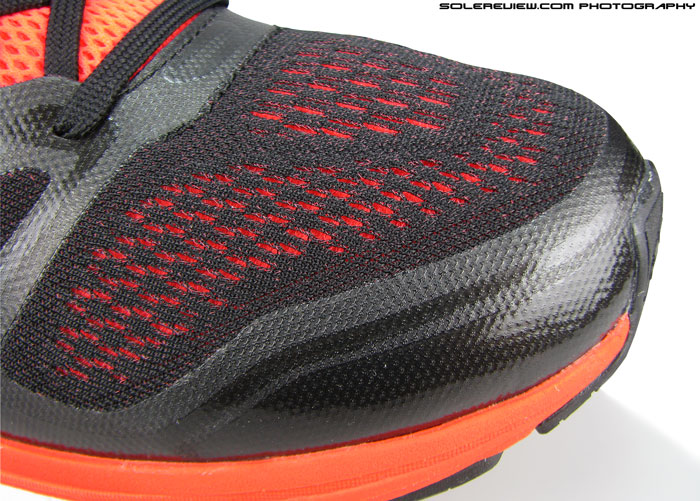
The Sequence 7 Boost uses an engineered mesh which is also a dual-layered spacer mesh. Overlays are welded, with glossy markings adding aesthetic depth.
Upper design has a common link with Glide Boost and last year’s Sequence 6, with familiar looking midfoot panels, materials and overall execution. The toe box is engineered spacer mesh, with a perforated top side connected by yarns to another layer of mesh, the latter functioning as inner lining. Forefoot overlays are all welds, a mix of how things were in the Sonic and Glide Boost. The welds have another layer of glossy printing, which adds an element of depth to the design.
Air flow in the upper sits somewhere on the breathability median. It isn’t as breezy as some of lighter Boosts (adios, Boston), yet isn’t uncomfortably stuffy. The upper layer of air mesh might have visible and effective perforations, but the lining beneath is a close type knit.
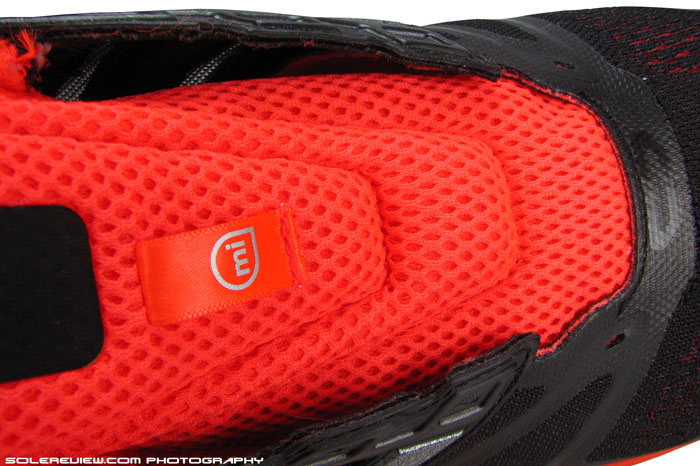
Tongue identical to that on Glide 6 Boost; quilt-stitched with foam in between. MiCoach callout is confusing, as the shoe does not boast of a cavity to pop the pod in.
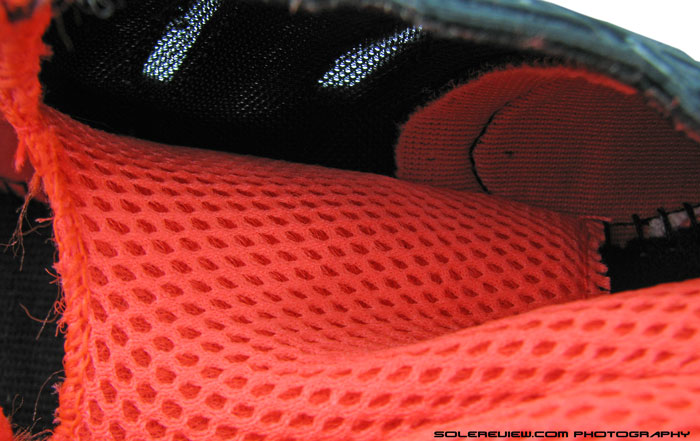
Here’s taking a close look at the mini-sleeve. It is attached on the same base as the external upper shell.
Tongue is padded air mesh which looks, feels and performs identical to Glide Boost. It is tethered to upper base by a wide gusset (not a full inner sleeve), which wraps around midfoot. Unlike Nike sleeves which come attached slightly removed from the midsole-upper joining point, the Sequence gusset is stitched along with the upper base. There’s a miCoach callout on the tongue, but like the Supernova Glide 6, it does not feature a cavity.
This frees some space around the midfoot base, and keeps the inner sleeve fit more relaxed than an equivalent in Nike.
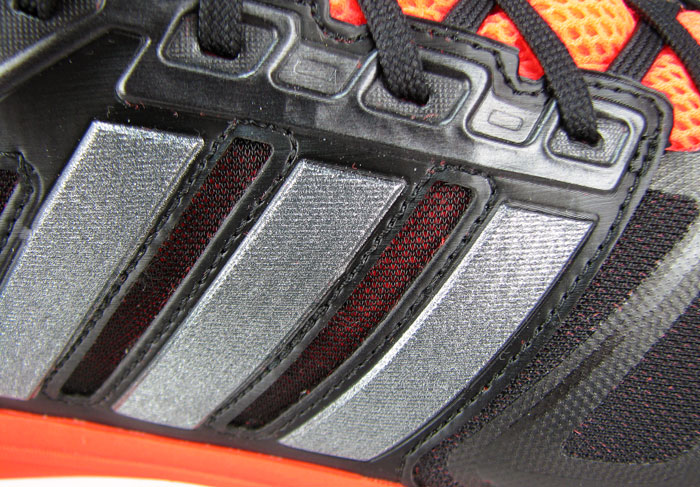
Synthetic leather midfoot panels which also serve as brand logos. Embossed side stripes, and eyelets.
Running along the sides are embossed synthetic leather panels which also serve as 3-stripe adidas logos. Slits with single layer, mono mesh are placed in the panel, with the intent of providing ventilation. These panels extend towards the rear and morph into heel side flanks.
Upper heel is standard stuff, with an internal stiffener and collar lining back-padded with foam and soft mesh. Collar foam extends a little further on the lateral side, compared to inner side. So much so that if you splay the upper a bit, you’ll see a portion of grey foam sticking out inside. (pictured above).
The Achilles heel dip is curved inwards and is soft, helped by foam sandwiched between two layers of mesh. Embossing on synthetic leather gives a degree of cosmetic detail on the heel, though it’s hard to see the adidas text on medial side.
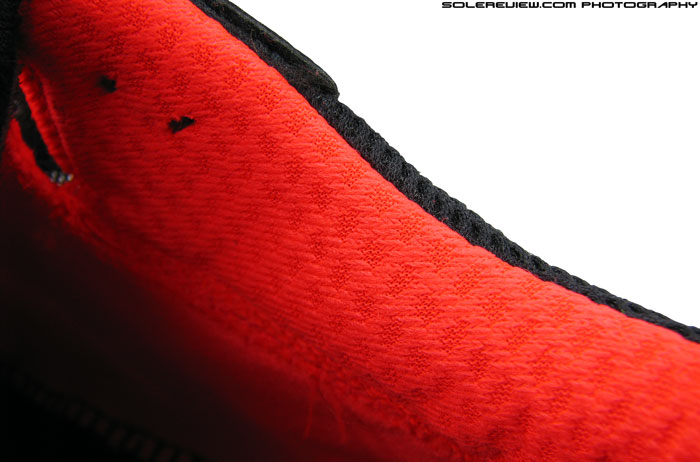
Soft collar lining. This is the medial collar, where there’s (intentionally) less foam compared to lateral side.
All these parts come together to result in a great, all round quality of upper fit. There are no pressure hot or blind spots, with a satisfying consistency of fit no matter which part of the upper. The lining feels seamless inside, making the shoe suitable for barefoot runs too. Lacing is wide across with generous spacing from rear to front. Combine that with padded tongue, and there’s no lacing pressure felt.
Yes, the tongue is a little longer and part of it sticks out like a flap near the collar, but it is not a functional negative. Visual eyesore? Maybe, but then that is subjective. Collar grips the foot well, with no slips experienced during runs.
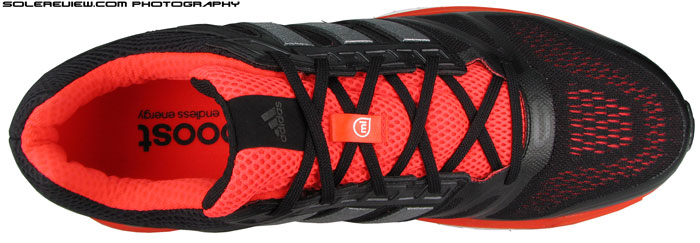
Upper fit is consistent, and if you’re used to adidas running shoes, the Sequence 7 fit should make you happy. Sizing is true.
As far as sizing is concerned Sequence Boost goes true. You just have to manage expectations with a snug, shallow-but-not-tight forefoot which is not specific to Sequence, but happens to be textbook adidas fit. This runs in the family, so to speak.
The thick insole helps prop up the foot too. The markings on its rear says something about being 6 mm, and it feels so, at least in the forefoot. The center of heel area feels flatter in comparison, and it is likely due to the extra pressure applied during molding.
Adidas is no exception here, we’ve felt a similar variation in other shoes too. Otherwise, the insole is a comfortable piece of under-foot foam lining which reduces the relative firmness of Stable Frame layer. This is one part which the Sequence 7 shares with Glide Boost, the latter’s insole being an exact replica.
Despite the midfoot half sleeve and molded insole, you won’t sense the upper providing a superlative level of arch support. It’s adequate, but not outstanding.
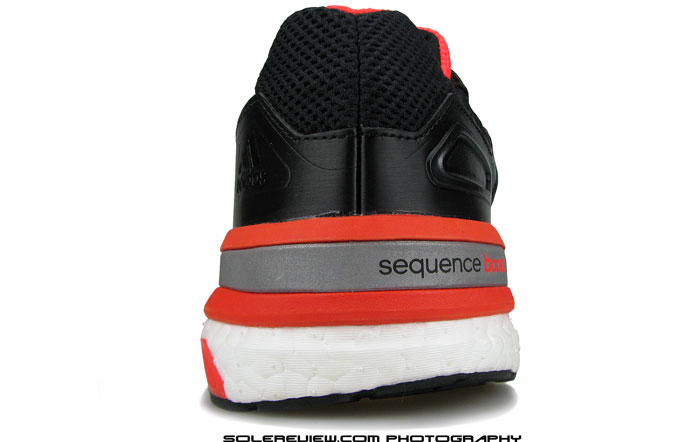
Unlike traditional support shoes, cushioning/compression is uniform across either sides. The midsole taper and heel bevel? That’s seen on most adidas running shoes.
The Sequence 7 Boost deals with its stability label not by employing laterally biased cushioning, but by applying an element of uniform firmness throughout. In what’s a different treatment from how familiar stability shoes are built, the single density Boost foam cuts across the heel width. This makes compression on either sides uniform – in contrast to convention, which would be to make the lateral softer and medial softer. This separates the Sequence functionally from models like Saucony Guide and Nike Structure, where a softer outer midsole helps controls foot-roll. So before you put down your money on the Sequence, you should be aware of what this shoe actually is.
The best way to look at Supernova Sequence 7’s ride is to do so from a Glide Boost lens. The upper feels near identical across both models except for minor tweaks, and the sole uses same materials, albeit in different doses. If you have experience running in the neutral Glide Boost, and switch to Sequence 7, then you’ll end up feeling that the shoe is a firmer version of the Glide. It feels cushioned, yet mixed in with a quart of firmness. And nowhere does it feel that your foot is leaning outwards, like in many pronation control shoes. EVA fill on medial midfoot and plastic ‘levee’ helps dial in a degree of firmness, but at the same time does not eat into the neutral vibe of heel cushioning.
One could argue that the prominent heel bevel on outer side combined with a sideways (lateral to medial) tapering of Boost foam would induce extreme motion control. Even if we assumed that to be a valid case, then the Glide Boost does something similar too.
Boost is pretty much the cushioning hero here, but given its toned down volume, isn’t in the same bouncy league as Energy Boost or even the Glide Boost. Heel and forefoot compression is definitely felt, but a bit diluted by the firmer EVA layer on top. The shoe turns stiffer once you cross the forefoot point, under the base of your toes. The area medially located under the big toe feels a bit odd, pushing the toe up towards the toe box. Noticeable at first, but ceases to be a bother once miles pile on.
Quality of transition is a definite positive on the Supernova; firmer upper EVA midsole loaded over Boost helps smoother, forward weight transfer. The heel crash pad might not be articulated like a formation unit, but it’s angled upwards to allow gradual foot strikes – much in the manner of Energy and Glide Boost.
Heel feels planted in the ‘bucket’ like construction of the midsole. The walls rise up around 10 mm (above where the reflective strip is) and delivers a good level of foot seating. Arch support isn’t much of a thing on Sequence 7. Sure, the midsole is very stable, with firm EVA acting as a supportive base. But the midsole lacks any flare or shape which could hug the under-arch area. Won’t be wrong in saying that the midsole design seconds upper’s stand on arch-support – adequate, but not super.
Considering the addition of EVA layer, the Sequence 7 does a decent job at managing weight. At 326 gm / 11.7 ounces for a half pair for US 11, it sits at the lower end of weight spectrum within the category of stability shoes. This would have the shoe tip the scale equally with Structure 18, while being around 20-30 grams lighter than shoes like Kayano 21, GT 1000 3 or Adrenaline 14. The only shoe which comes in a lot lighter is Saucony Guide 7.
The Sequence 7 is not a running shoe which is going to blow you away by being spectacular in any one area. Not every shoe has a heavily marketed feature worthy of filling a digital spread, and the Sequence is one such example. Ok, the Boost foam’s in there, but its now ubiquitous nature makes it far from novel.
Instead, it comes across as a capable, daily workhorse which puts everything together very well, much like the footwear equivalent of an untiring home appliance. adidas says that the Supernova Sequence 7 Boost combines cushioning and stability, and that’s exactly what the shoe is, minus deviations from the brief.
And try as we might, it’s hard to find functional faults here, and that’s saying something. Ok, maybe there’s that $10 increase in price over Sequence 6, but then, everyone’s playing that game. Why single adidas out?
(Disclaimer: Solereview paid full US retail price for the shoe reviewed)


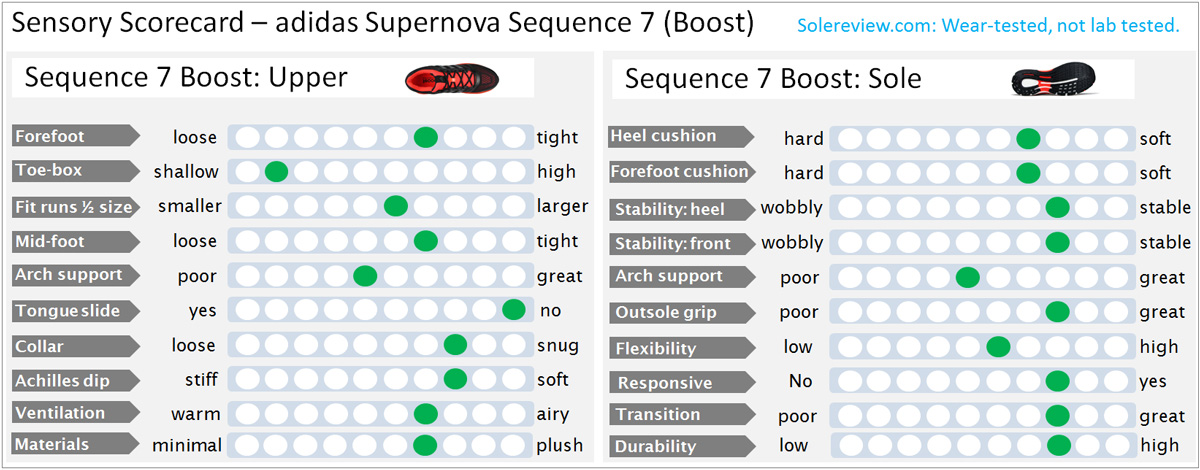
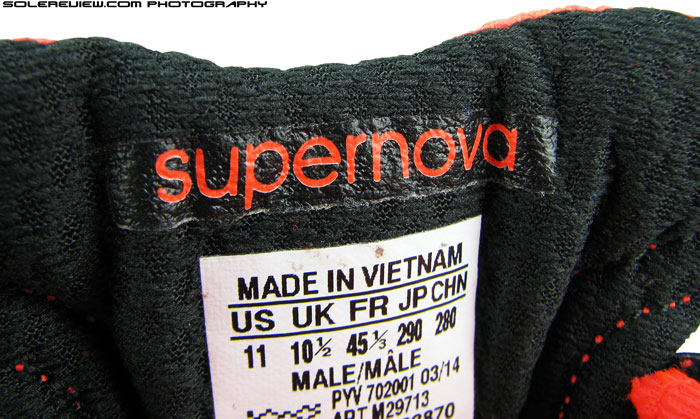
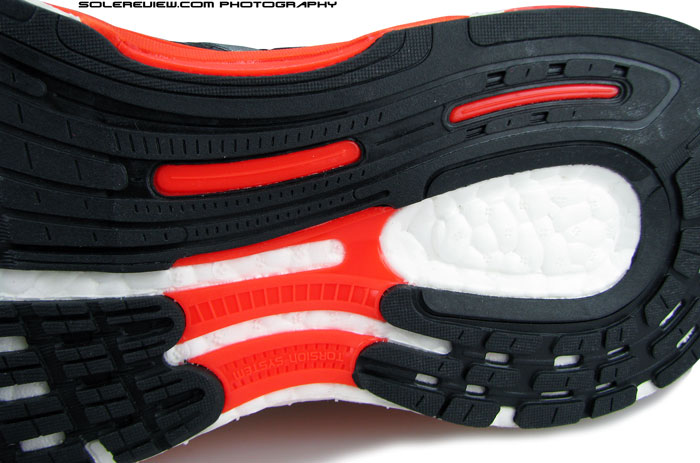
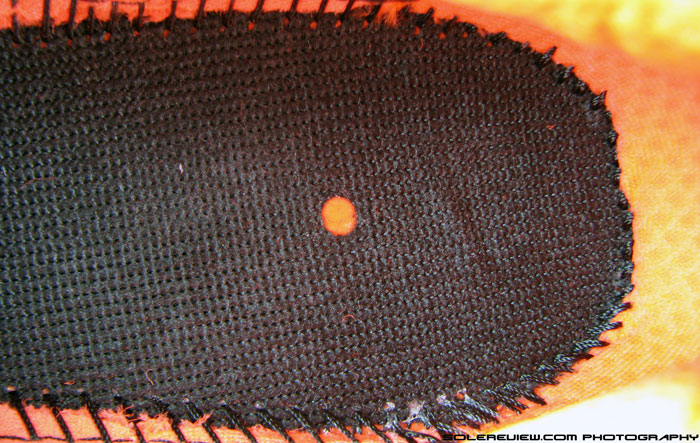
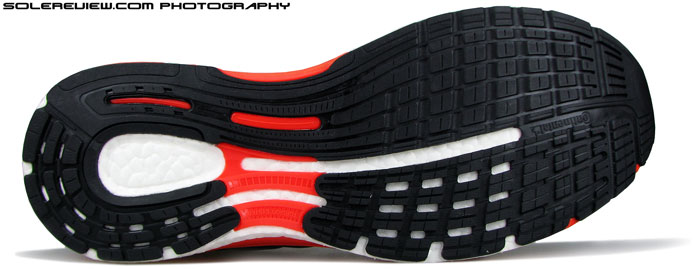
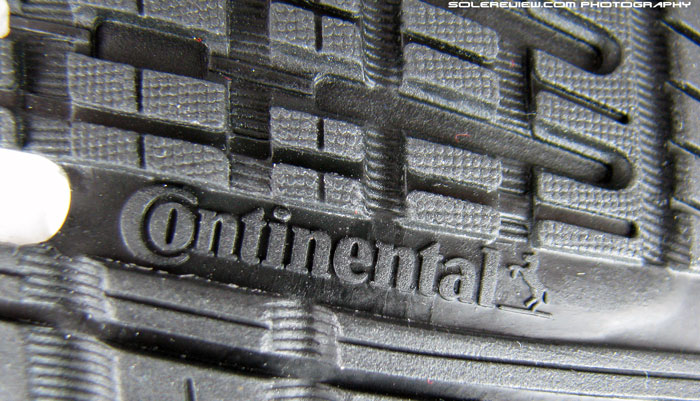
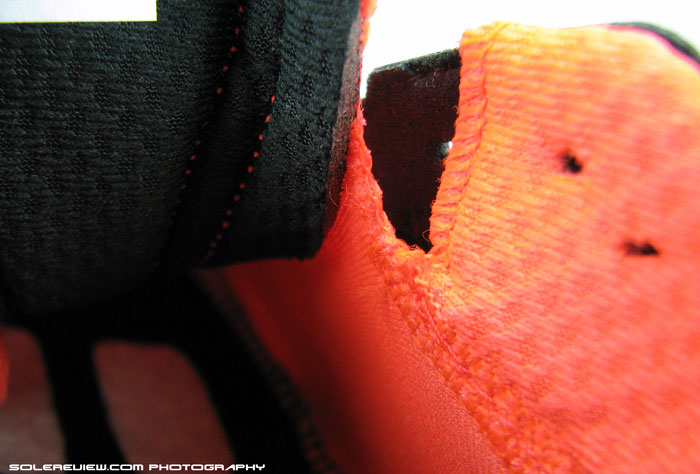
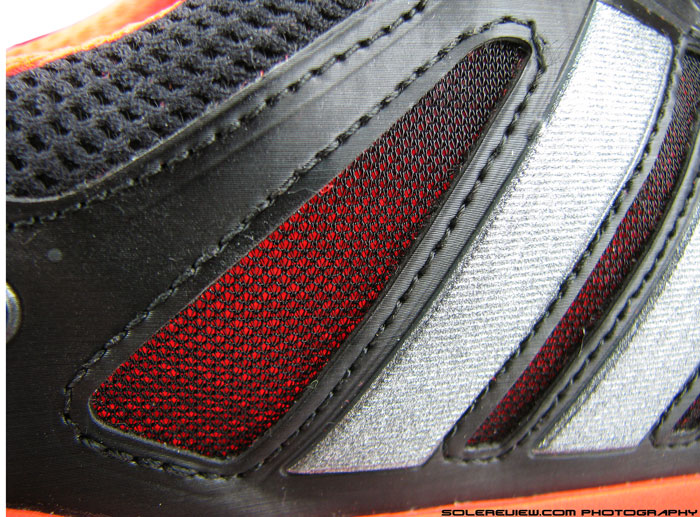
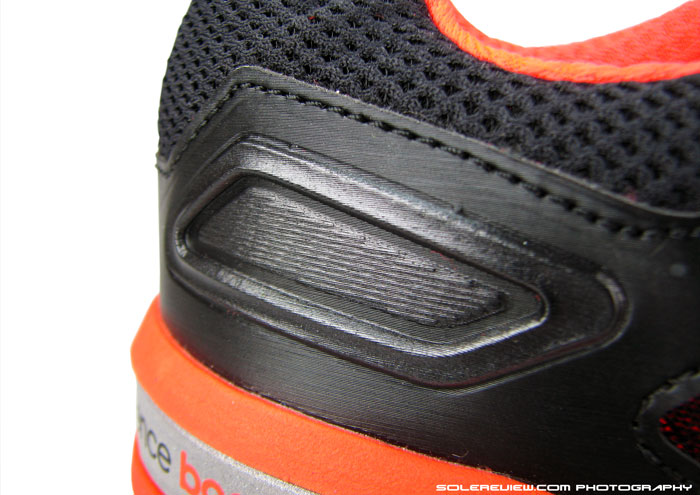
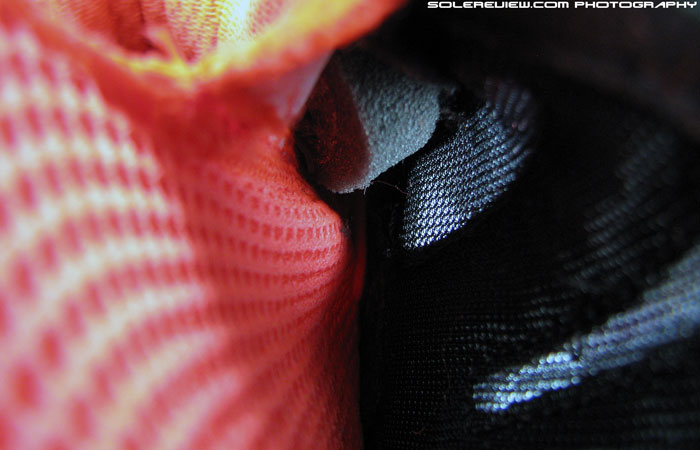
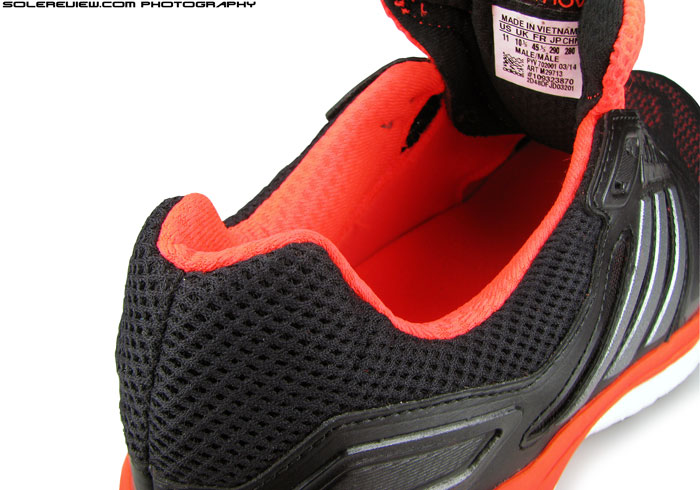
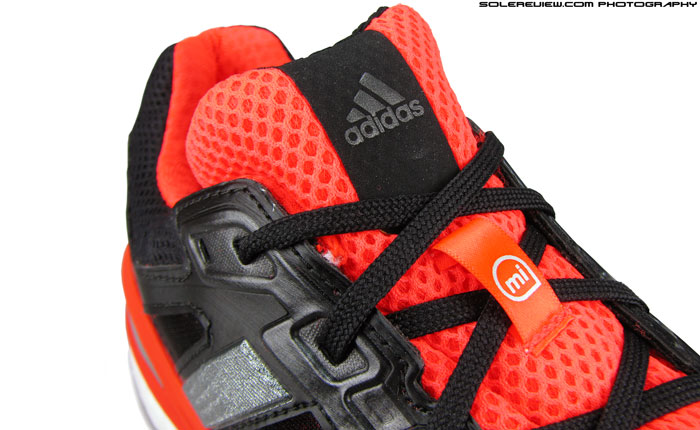
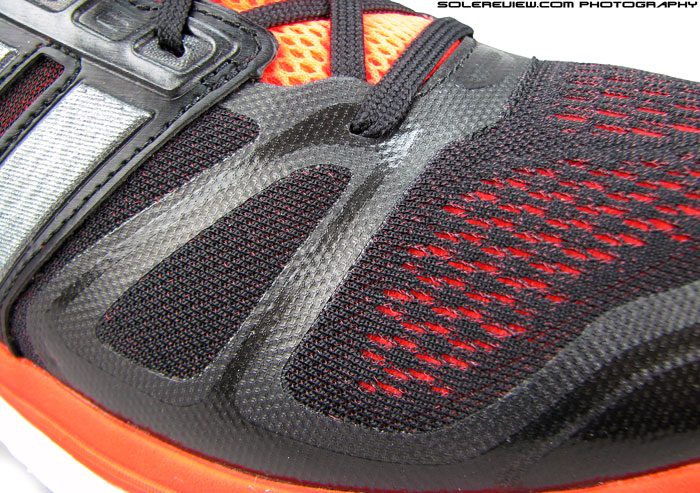
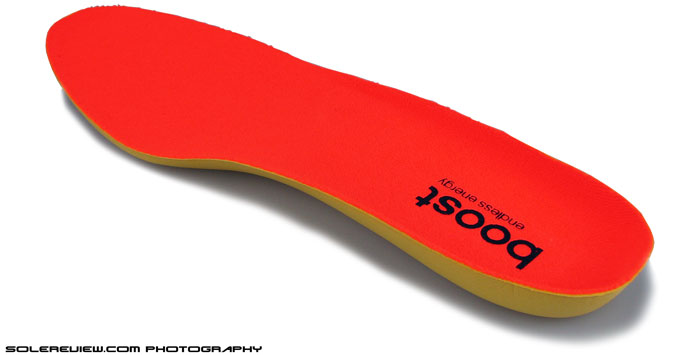
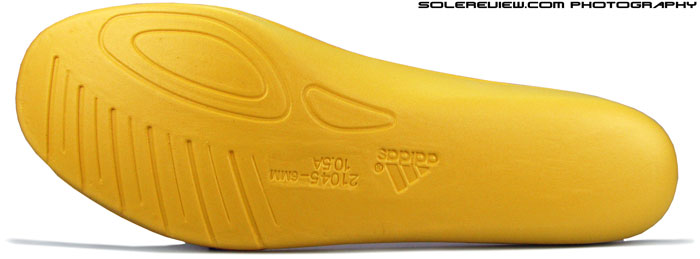
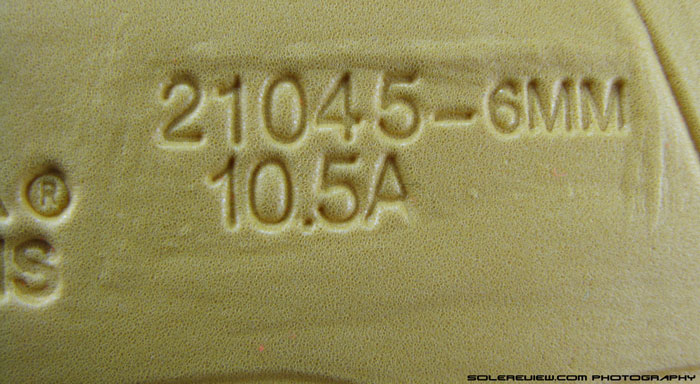
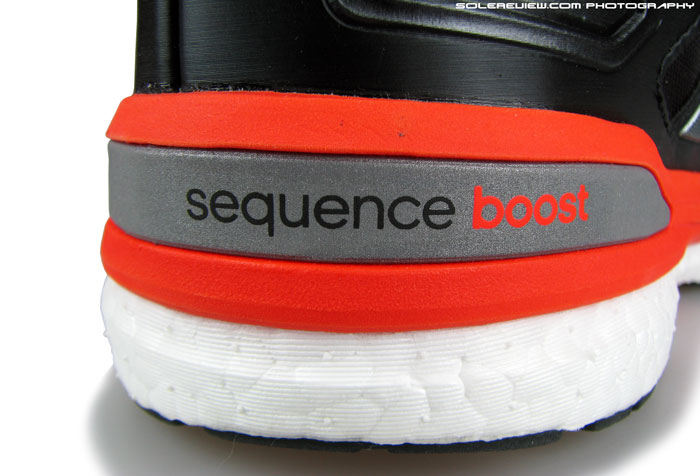
85 comments
Excellent review as usual, but if this shoe is firmer that the Glide Boost, it’s basically a piece wood.
those actually have the perfect balance for me.. firm and bounce to some degree
Thanks for another great review! So would that be a Glide for heavier runners? Without the “Promoderator” inserts it seems it might not help pronators as much.
Is it another “miCoach” branded shoe like the Glide without any actual slot for the footpod or it’s not pictured as you’d called that out in your GB6 review ? I’m still not sure what Adidas had in mind for the Glide…a late design change possibly ?
You write it runs true to size in US11 but you’d upsized to that for the Boston Boost vs 10.5 for the Adios Boost 2 and Glide Boost ?
The upper part doesn’t seem to be as comfy as the Glide’s with that strip in the front and the odd Adios Boost 1 laces eyelets?
I have Glide 6 Boost in men’s 8.5 and tried on Sequence Boost about two months ago at Road Runner Sports.
The sizing was exactly the same. The upper feels exactly the same in terms of toe box and how it wraps around my feet. The soles behaved VERY differently compared to the Glide Boost, as expected. I’d say the support is a bit too much for me. I can feel everything from the additional torsion piece at heel strike to the stableframe at midstance. Definitely not the same as the one piece boost foam of the Glide. Heavy pronators might just find them suitable.
Yes, you could say that, the Sequence might suit some heavier runners in need of stable cushioning. As far as the lack of Pro-moderator is concerned, this shoe might or might not suit overpronators -really depends on a case by case basis.
You’re right, the miCoach is just a marker with no actual cavity inside. Thanks for the pointer, we’ll include it in this review.
Ok, we can see where the sizing confusion is coming from, that row in sensory score can potentially have different interpretations. In this review, the green dot is in the center, which means the shoe runs true to size. The Boston 5 was the same US 11 size, but we did mention that you might need buy half a size up – hence the location of green dot is on the ‘smaller’ scale. The Adios Boost used a different format for that row, so a comparison will not be valid.
Great catch on the forefoot strip. Initially we thought that would make the forefoot snugger than the Glide, but you know what, it does not seem to. We actually spent some time (stationary and multiple runs) making sure of that.
We did not feel any drop in upper comfort vs the Glide. Could be a minor difference or two, but in our opinion none worth writing about.
Thanks for the additional info, really odd about miCoach, we must be missing something ;-)
Just to get to the bottom of the sizing question since there was a quite a bit debate about it in the BB5 review comments, I could see the need to upsize to 11 for the BB5 if a pair of 10.5 GB6 is “just right”, but not for the SB7 I would have thought?
Yes, you’re right in your assumption about not upsizing to SB7 if a particular size in GB6 was just right.
Don’t think neither of us is missing the miCoach picture, there’s nothing about it on the adidas Sequence 7 webpage. Perhaps adidas is hoping that people will google miCoach once they see that on the shoe, and will sign up!
I guess the micoach “compatibility” is so you can pick that shoe type from the preconfigured Adidas shoe list on the micoach web page – the one that you use to track your shoe wearing over time.
Great review -Thanks!
I started out running in Brooks Beasts about 7 years ago, experimented with a few Nike shoes along the way (wrong shoes for me) and ran in the Adidas Salvation 3 until it was discontinued.
I pronate quite dramatically & need support/ structure in my running shoes. Before buying the supernova 7’s I tested a few shoes on a treadmill with a slow motion camera – interesting results: ascis kayano 21 – worst pronation control. Brooks adrenaline gts 14 slightly better, but not as good as I expected. Nike structure 18 very good (best Nike i’ve tested so far) & Adidas supernova sequence boost showed the best control out of the four shoes.
I believe everyones needs are different, but it looks like the lack of arch support does not translate directly into lack of pronation control? (I have normal arches)
looking forward to putting some miles on the new Adidas and seeing how they perform on long runs..
Your test results make sense. The Kayano 21 is extremely soft, so no surprises there. However, would have thought the Structure 18 to come in higher than Sequence Boost, but then everyone’s different.
The arch support or lack of it might or might not negatively influence pronation control. It turned out this way for you, but it might be the other way round for some else.
you said that there’s no “cons” worth to mention while energy boost have lack in The plastic midfoot cage. do you think this is the best comfort boost ever? which one do you like?
Hi – the Sequence 7 is in a different category than Energy Boost, and as a standalone shoe, it has no faults worth mentioning.
However, this does not make the shoe most comfortable. The Energy Boost 2 ESM has definitely more cushioning, and so does the Supernova Glide 6.
Hi! Happy New Year and thanks a lot for your reviews, they are really helpful! Cost and looks aside, what shoe do you recommend for 90 minutes running every day? Asics Gel Kayano 21, Nike AIR MAX 2015, Adidas Energy Boost 2.0 ESM or something else? Is the Nike much inferior compared to the Asics or Adidas?
Wish you a great new year too.
What shoes have worked for you in the past, and your question doesn’t say what exactly you’re looking for in a shoe. (cushioning, stability, pace, etc)
Hard to generalize how one brand is better than another. In some shoe, brand ‘A’ is better, and in another, brand ‘B’ does well.
Great review as always! What’s the water durability if boost shoes? I was wearing my supernova glides, and accidentally stepped in a deep water filled pothole. Did I ruin my shoes? 0.0
Not really. If the water was dirty, better to gentle hand-wash the shoe in a bucket full of warm water and soft detergent (or shoe shampoo). Leave to dry in shade for a day.
is “91 %” the same as “9,1/10” ?
Yes.
I’m currently using the Adidas Response Stability 5, will i notice a big diference from buying and running with the Supernova Sequence 7?
Thanks
We haven’t tested the Response Stability, so would be unable to offer any advice. Sorry about that!
So based on your gushing review I tried out some Sequence 7’s on the treadmill at my LRS and loved ’em, so I picked up a pair. I’ve got three short runs on them so far (7 miles total) and love them. But there’s one problem. In each of the last two runs (3 and 2 miles, respectively) I’ve gotten a small blister on my arch. Any reason for this, and have you all experienced anything similar when breaking in a new Adidas? I know they fit a tough narrower than (for instance) a comparable Asics or Saucony, but is this something that I can expect to subside as the shoe breaks in? I otherwise love the shoes, so it’d be a shame if I had to take them back because of this. I’m running in Balega Hidden Comfort and Balega Blister Resistant socks. They have quite a few miles on them already, so I think I’ll stop by the LRS to pick up a fresh pair of blister resistant ones to see if it helps.
That’s unusual, we did not face this issue on our pair. The only reason we can think of is the forward seam of the gusset getting in the way. Where exactly is the location of the blister?
Right about the halfway point on the length of my foot, on my arch – sorry, a horrifically unscientific explanation!
Forgot to add that I just ordered a 12.5 to see if that’ll ease it. I certainly hope it does, because I otherwise really, really like them.
From the sound of it, it might be a wayward seam of the sleeve. Hope the 12.5 works out!
So the 12.5’s arrived last night and I took them out for a 5K spin this morning. Same result – arch area blisters again, this time slightly more forward in the arch than the ones I got while wearing the 12’s. Upon carefully examining my wounds and both shoes, I’ve concluded that the tongue gusset/sleeve is the culprit! The blisters come up right on the forward edge of the sleeve. Unfortunately it’s back to the drawing board for me with the Sequence – unless anyone knows of a solution to keep this friction from being a problem. Maybe taping my arches for a little more “armor protection?”
Hi guys i am a heavy set male with flat feet. Should i go for sequence or glide? Thanks.
How exactly do you want your shoe to feel like? Any history of shoes which you’ve liked in the past?
I am actually a complete novice at this but i do think for me support and cushioning is important being heavy set and all. Thanks
In that case, the Sequence should do it. The Glide is also stable, and has more cushioning if you need it. Try getting yourself fitted and see how both feel.
What are your thoughts on this shoe – need stability shoe
Mod overpronator with lat heel strike – so need stable heel for heavy runner …but I want cushion too
Otherwise I am contemplating gts14 brooks
Thank you
Sorry for the delayed reply.
This shoes has great overall stability and there’s cushioning too. If the upper fits, then the Sequence 7 is a good match for your needs.
Thank you, noticed adidas has another stability shoe Adistar Boost ESM
Do you know how this show compares to Sequence?
Absolutely no idea. Have zero miles on the adistar Boost.
Thank You! Great shoe reviews
How does the Supernova Sequence 7 compare to the Saucony Omni 13? I am looking for support, but I find the Omi 13 to much. I love the Saucony Guide 7. That shoe is great for shorter runs, but when I get tired on longer runs and my footwork gets sloppy, I need more correction and stability. The Omni 13 does that, but too much. I am looking for something in between comparing the Guide 7 and the Omni 13. Could that be the Supernova Sequence 7?
Sorry, can’t offer an opinion since we haven’t reviewed the Omni 13.
I have the same problem: I’m running in Omni 13 now, but was looking for a step down when it comes to support on the inside of the foot. The Guide 7 feels a bit too soft IMO. Last Monday I picked up a pair of Sequence Boost 7’s (Saw they were priced down quite a bit and being Dutch..) and made 2 small recovery runs in them. What I can say now is that they feel very stable, even compared to the Omni, and that they have great cushioning. The overall feel is very solid without having the extreme inward stability/correction of the Omni.
Thanks Eric for for your reply! Where did you find your pair with discount? And is the size equal to the size of your pair of Omni’s?
Adidas and Saucony use different sizing: My Omni’s are a US9/42,5. For the Adidas I chose also a size 9, which means 42,7. Because the Adidas are a bit narrower it’s fair to say you can take the same size, I think.
I bought mine in Rotterdam at Daka. You can probably also find them online.
I have not made any long runs in them yet, so I cannot compare them in that sense. Probably after the weekend.
Thanks again Erik. I found myself a pair online with a nice dicount at Keller Sports. I see forward to the running experience in Sequence Boost 7!
Hey there!
That will be my first time buying a running shoes and I just want to be sure I will make a good choice. I am 1.92m and 100kg with pronated feet.
I started to run 2 weeks ago and since I have made a surgery on my left knee I want to BE SURE that I won’t make any mistake when buying shoes.
Do you guys would recommend that one for me?
Thanks!
Hi Vitor,
You haven’t mentioned what kind of upper fit you need (roomy, narrow), whether the ride needs to be soft or firm or if there was a type which the doctor might have advised post your surgery.
Throw us some parameters, and then we can help.
Hey there! Well currently I am running on a treadmill but soon enough I will be running in the pavement. As I said I have no idea of anything like that so I will let help me with that as well.
If the upper fit doesn’t affect performance I do not care at all about it. And about my surgery my doctor said I am good to do anything!
Thank you!
You could try shoes which combine cushioning and support in equal measure: The adidas Supernova Glide Boost, UA Speedform Gemini, The Saucony Breakthru or Ride 7, Puma Ignite, Asics Nimbus 16.
All these are very different from one another, so suggest you try all of them and see which one fits and feels best.
Hey there – thanks for this review and it’s one I agree with. Have been a long time Adidas Supernova user and you’re right, it’s my ‘work horse’ shoe.
As you point out, it’s not an ideal race shoe. For someone who appreciates the support and cushionining level offered by this shoe, could you please suggest or recommend a lighter racing shoe that might have a similar feel to it?
Thanks!
You could give either the Boston 5 Boost or Tempo 7 Boost a go. Fit try both and see which one feels better. Technically, the Tempo 7 is a lightweight match for the Sequence 7, but we personally like the Boston 5. Both reviews here:
https://www.solereview.com/adidas-adizero-boston-5-boost-review/
https://www.solereview.com/adidas-adizero-tempo-7-boost-review/
Boston 5 or Sequence 7 for a daily trainer and marathon on 3h?
Boston 5.
Thanks.
First of all, thank you for the very detailed and entertaining reviews. I’m finding the site very helpful.
I had a pair of the Sequence 7’s for a few months now and they are lovely, their fit is great for my narrower feet. I do find them quite bulky though.
I would have the same question for you as Jo did but taking into account that I over pronate, I’m 191cm/85kg and training for/ doing ground work for my first marathon which I’m planning for next year. Aiming for a time around 3:45.
Do you think it would be too ambitious for me to rotate in a pair of Bostons into training and aim to run the Marathon in them? If you wouldn’t recommend the above, what do you think would be a good alternative as a light/supportive shoe? Thank you for your reply. T
We see no issues in weaving the Boston in, and going the full 26.2 in them. This is a more cushioned version of the adios Boost, a shoe which is seen a lot on the marathon pro-circuit.
And if you’re not particular about the brand, even the Nike LunarTempo is great – both for training and for race day. The upper is certainly more comfortable than the Boston Boost.
Thanks for the help guys!
Thank you for the amazing reviews! Any plans to review the Supernova Sequence 8 anytime soon?
Next month!
thanks so much for the review. I’ve started running 1 year ago and the glide 6 was my first shoe ever and i was really happy with them but never run another shoe :-). after 800km I’ve decided to test some new shoes so i bought the energy boost 2. I can do what i want but i’m not really happy with them. I’ve always the feeling that the heel isn’t tight enough and with marathon lacing i get some pain at the instep after 6-8km. It’s like if i’m having no halt in the shoe but size is ok. I’ve the ultra boost too but only for daily use at work etc. So i’m wondering to go back to the glide because the fitting was perfect means nearly like a sock. Actual the glide 6 is in sale. Make it sense to pay more for the glide 7 or is it OK to stay with the 6 because of 50% cheaper. Also I’m wondering about the size fitting of the glide 7. Is it ok to order the same size for the glide 7 in compare to the glide 6? Thanks for a little answer.
The Energy Boost 2 has that plastic cage, hence the discomfort around instep/midfoot. If you’re getting the Glide 6 at a great price, absolutely no reason to switch to the Glide 7. These are very similar, only minor changes. And yes, go same size for both Glide 6 and 7.
I have them, and I love them.
I’m a midfoot striker and with the firmer ride, they feel fast, but i think when you are a heavy heel striker they suck, too much forces on my knee when I land on my heel. in that case you’r beter of with kayano’s or something like that, but Kayano’s feel sluggy, can’t do any fast runs in it.
I think they are also better then the much more expensive adistar boost, the sole is smaller than my foot is, and roll too much on the outer edges with de adistar boost.
I’m an overpronator, but I tried several neutral shoes because I always thought, that stability shoes is just an marketing gimmick, but in all neutral shoes I always kept sore calves, and i won’t have it in stability shoes.
One of the reasons you have sore calves could be because of a softer midsole, which could compress during landings and expand your lower leg muscle system.
Im very loyal with Adidas.. I used Glide 5 and Glide 6.. It is a good idea to try Sequence 6 for my half marathon? And i am overpronator
Sorry, we don’t have any wear-test experience with the Sequence 6, so can’t offer an opinion.
Sorry for my mistake, I mean Sequence 7. In my mind now,want to continues with Glide 7
Then why not continue with the Glide 7? It is a great shoe.
Hi… I am currently using GoRun Ride 3 and am planning to upgrade to Supernova 7…. I love the gorun ride for the stability and the cushioning that it provides… Will the supernova 7 be a right choice?
If you like Skechers, why not stick to it? The new GoRun Ultra Road or the GoRun Strada (Skecher’s ‘stability’ model) are good alternatives.
The Sequence 7 is very different from the Ride 3. In the sense that it is firmer and narrower on the fit side.
Hi, I bought these shoes after running with Nike Structure 13’s for years, I liked the Nike structures so much I bougfht another Pair but they wore out over the years. I bought Adidas Sequence 7’s on the advice from a professional shoe store who analysed my foot strike with technology.
Walking on them felt good. I run a 5km with them, then a days rest then an 11km. After this I started to feel pain in the calves and feet. I continued after 4 days rest and the pain subsided, and the pain in the feet and calves came back but in a real bad way. I gave it another week and then tried a very short run and stopped myself due to pain.
Now im stuck with Plantar Faciitis for a month and am trying to get better. My Question is: Do I continue with these shoes when I get better or is it best to try and find another pair?
We would recommend that you discontinue the use of the shoe. Not sure what exactly is causing the pain, so consulting a physio is recommended.
I have been having similar problems after running several times only with Nike lunarglide 5. I have been using Asics 2000 series since 2010 . I keep running with GT , I felt so strange when I first used GT . I did not feel the ground for a few months. Since then, I can not run with any other shoes. But Plantar Faciitis is still a problem.
What’s the difference between motion control and neutral? If I switch from The Sequence 7 to a neutral shoe, will that affect me?
The difference lies in the way the shoe tries to ‘correct’ your gait, hence the word control. Usually firmer midsole medially and softer laterally (outer) is a design hallmark of motion control shoes, while neutral keeps it balanced.
Not sure what you mean by ‘affect’, but it really depends on which shoe you’re transitioning into from the Sequence.
Hello, thank you for the great review! QUick quesion: I have alway worn the Sequence series (2,3,5 now 7) and would like to rotate in the Boston for racing.
One of the reasons I always wore Sequence is due to my narrow, flat, overpronating feet. Would the Boston wider E profile be an issue? Also, based on your review, would I most likely need a 13 size instead of my Sequence 12.5?
Thanks!
Forefoot space should not be an issue, and we think you might have to size up – but foot shapes differ from runner to runner, so the best way is to personally try them on and see how they fit/feel.
Also consider the Tempo Boost, it mirrors the Sequence 7/8 construction, but is lighter like the Boston.
Hi,
So after a four month lay off from running for a broken foot (fourth and fifth metatarsals) I found out I got into the London Marathon! This follows the layoff for plantar fasciitis so I’m not doing well…
I started running again a month ago with my nimbus 17s (I’ve found them fine with an aftermarket insole) but unfortunately the inner heel padding totally wore away on the left shoe last week -pretty terrible considering I only put about 150 miles on them!
So I’ve given up on Asics now, they’ve been getting too soft and this is the second pair to last no time at all.
These Adidas seem like the best bet (the nike vomero are over twice the price or id consider those) and as an added bonus I can get a cheap pair now the eight’s are out.
Nowhere near me sells them though so itll be a blind online purchase. So Questions (took me a while) – are these likely to play nicely with my feet with regards to avoiding a flare up of planter fasciitis and Will they take am aftermarket insole well or does the motion control mean it won’t be necessary? Does the size run similar to asics (uk size) or are they slightly smaller like adidas always used to be? And lastly are they a sensible choice for training and running a marathon in given the fact I’ve never run more than twelve miles before?
Thanks kindly,
Mike
Sorry the delayed reply, and to hear about your injury – hope recovery is around the corner for you, Michael!
In our opinion, the Sequence Boost will be a tad firm for you, given your history of Nimbus 17 and Cumulus 13/14. To specifically answer your questions:
1) Can’t say whether these will relieve your PF – always hard to determine that without prolonged personal use.
2) The Sequence 7 stock insole is fairly thick, so an aftermarket insole of the same thickness should be ok. It depends on what you want the insole to do – the Sequence is pretty firm in its standard form, so do you want the insole to soften the ride?
3) Sizing on the Sequence is larger than the Energy Boost/adios/Boston etc. But if you follow UK sizing in Asics, then half size up in the Sequence (UK 10 in Asics = 10.5 in adidas)
4) These will do ok for a marathon, but any reason why you don’t want to consider the Glide 7 Boost instead?
Hi, that’s
quite alright – I come here precisely for replies like that one,
regardless of the time it takes; rather than the instant ones devoid of information I could get elsewhere! Thanks so much for that response.
1)Understood – it’s a frustrating injury in that regard! If a shoe company would come out with a PF friendly running trainer that would be great…
2) I use the aftermarket insoles to support the arch and to try and avoid a repeat of PF – it’s hard to know whether that’s working or if I just recovered through rest/stretching,
but they’ve become rather a safety blanket at this point. They also had the benefit of being firmer (I use the CurrexSole RunPro) than the sockliner provided in the Asics Numbus 17, which was a benefit in that shoe as I mentioned in that review’s comments.
3) Brilliant, thanks!
4) There is no good reason other than I’ve read so many reviews that sometimes I forget shoes exist, this being one of them! I’d definitely look at getting the glide instead, but the Glide 7 currently costs £80+, whereas I can pick the Sequence 7 up for £49 and the Sequence 8 for £55. Would the extra softness in the Sequence 8 make it more or less suitable than the 7, in your opinion? And would the Glide 7 be worth the 50%+ price premium over the Sequence 7/8?
I’d love to throw money at any shoe but after being burnt by Asics for two pairs of shoes which lasted far less than 200 miles a piece I really need to look towards a lower budget option, unfortunately.
You’re welcome! Wish we had more hands on deck to respond to comments quicker :)
2) Knowing your history of Nimbus 15/Cumulus 13/Nimbus 17 with insole, our advice would be to leave the Sequence or Glide Boost untouched. Our sense is that a stock Sequence will feel firmer than the Nimbus 17+insole combo. The Glide Boost will be closer, or even slightly firmer in its standard configuration.
3)The Sequence Boost 7 is great, but we have no idea of how you’ll like them, considering your transition from softer Asics. Suggested Glide because it seems like a good bridge between old (asics) and new( Sequence). That said, a 50% price premium is certainly isn’t worth it.
Hi,
I need some help deciding on which pair of shoes I should get next for my winter training/indoor track season here in Chicago. As of right now I’ve been using the Nike Zoom Structure 18s and I think those shoes are okay but I want to try something new after going through 2 pairs of those. I think that the cushioning is a little too firm and not as responsive as I would like. I’ve been looking at the Supernova Sequence 7 and Saucony Guide 8 since I can find them for the low online.
I mildly overpronate so I do need a bit of support in my running shoes. If this helps I weigh about 145lbs. I also heel strike a little when I run, but I’m trying to become more of a forefoot striker and I was thinking that maybe the Guide 8s would be a solid shoe for me since the drop is 2mm less than the Structures and the cushioning is a little softer than the Structures. But I see that the Sequences are scored as more responsive and are softer, which is what I want out of my next pair of running shoes. I’m looking for something that will easily last me 500 miles, have comfortable cushioning, good traction especially since it’s the winter, and a fit that won’t annoy me during the runs.
Any advice would be greatly appreciated! Btw keep up the great work with the website, I really hope more people donate because they don’t realize how much of a deal the Front of the Line pass is considering all of the dedication that is put into this website and how much money you’re saving people by informing them to buy or not buy those shoes.
Alex
Alex, we’d recommend the Sequence over the Guide. And you should consider the Glide Boost as well – does not have the supportive medial side, but stable enough and cushioned too. Both the Sequence and Glide will last longer than the Guide.
Thank you so much for having our back! Means a lot to us.
I went shopping last night and I came across the Sequence 7s at Marshalls. They had a size up but I still tried them on to see how they felt and I fell in love with the cushioning right away because of how responsive and soft they are, especially compared to the Structure 18s. I waited for your response and now I just ordered them and I don’t think I’ll regret it, thanks!
The Sequence 7 is one of our fav models, and definitely better than the Structure 18. Should work out well for you.
Thanks – we’ve put out a few job postings, but at this time it appears that we won’t get both – reviewers who can do both the writing and photography bit. So it’s going to cost us extra, having to buy two pairs of shoes for each review :(
We’re grateful for whatever help our fundraising received, so from that measure it was a success! We’re making some changes here, like splitting the review into four pages and subscription model, so that will help run our engines for a while.
Would love to hear your feedback on the Glide Boost! Have a wonderful new year.
Hi guys!
I received an email from strava yesterday encouraging me to reward myself with a new pair of shoes as I’ve run 1,301 miles in my sequence boost 7s! They’re not done yet!!
That is massive! adidas has done a great job with the Glide and Sequence Boost outsoles.
Hi!
I’m currently deliberating between the Glide Boost 7 and Sequence Boost 7 for everyday mileage and wondered what you recommend? Brief shoe history: I started out in support shoes such as Brooks Adrenaline, then Nike Air Zoom Elite, but transitioned to neutral shoes about three years ago without any issues, including Brooks Defyance. I could stick with these but I really like the feel of Boost; I use Adios Boost and Boston Boost for racing (Adios up to 10k, Boston for marathon/half), and would like an equivalent for everyday training. I experimented with the UltraBoost, thinking that more Boost would be the answer, but they were WAAAY to cushioned, and a mere 12 miles of testing caused such issues with instability that it caused injury in my right foot. So I need something with better stability than the UltraBoost, but more cushioning than the Boston Boost for a comfortable ride over long training runs. I heel-strike a little, but am happy in neutral shoes. Both the Glide and Sequence appear to fit the bill on paper, but I’m torn between the relative amounts of firmness, and whether I need the extra stability of the Sequence. Any ideas?
The Glide Boost sounds perfect for your situation.
Comments are closed.